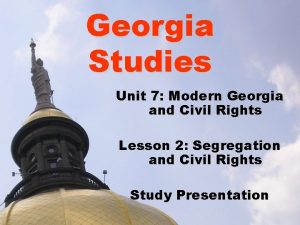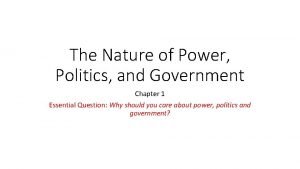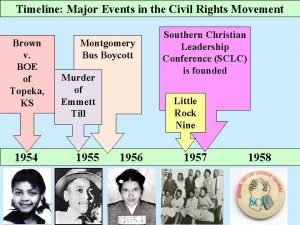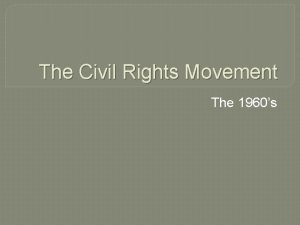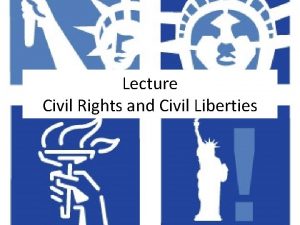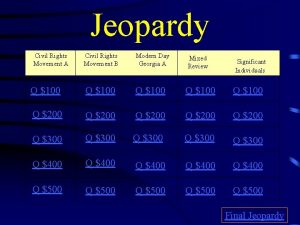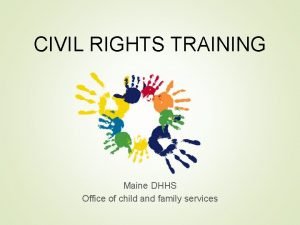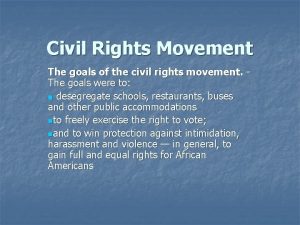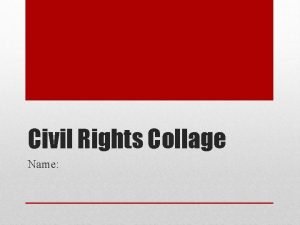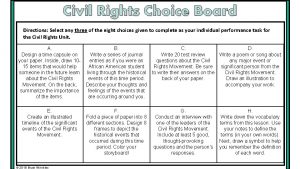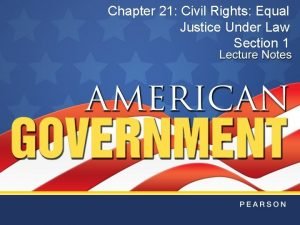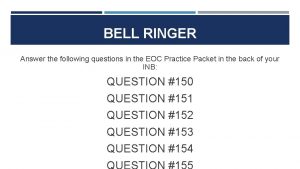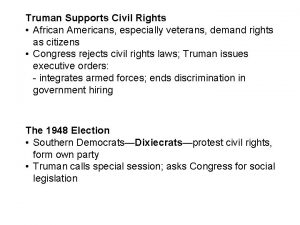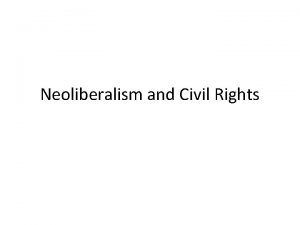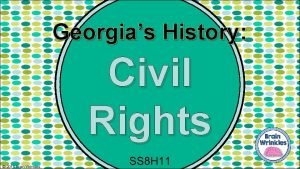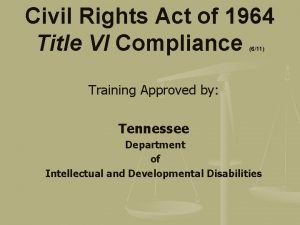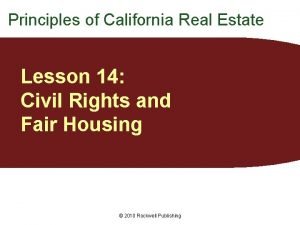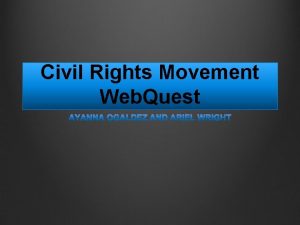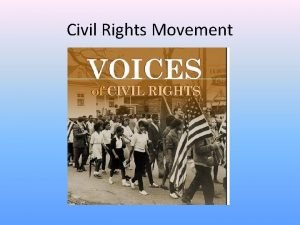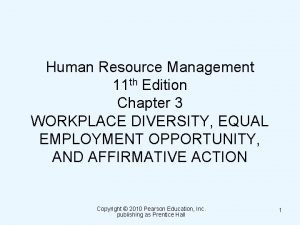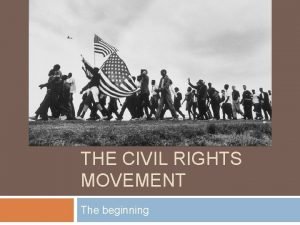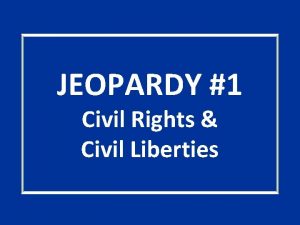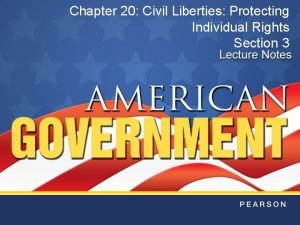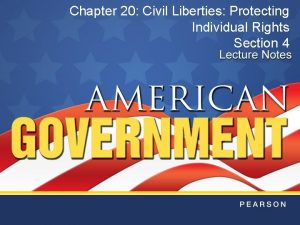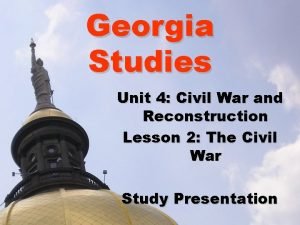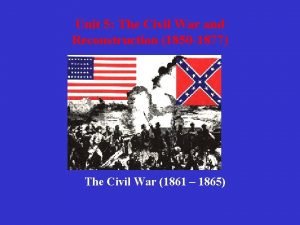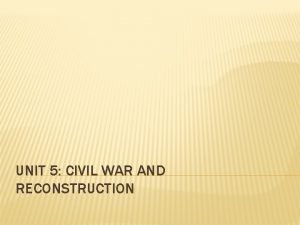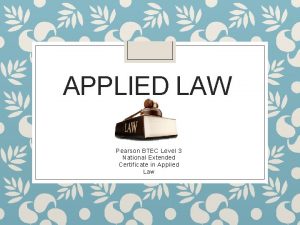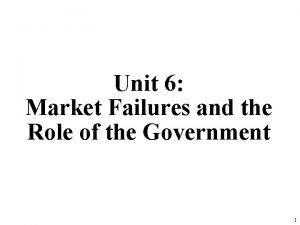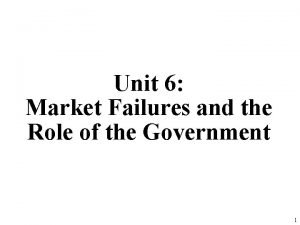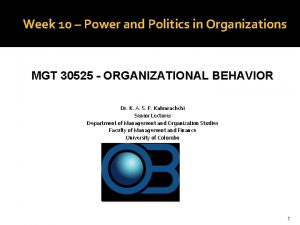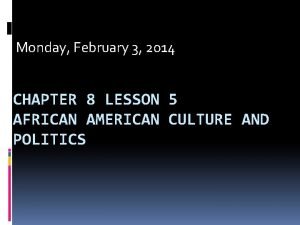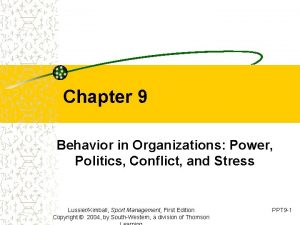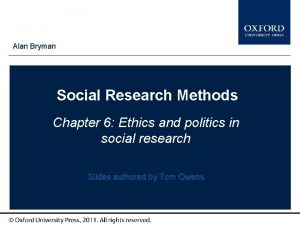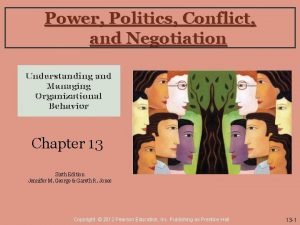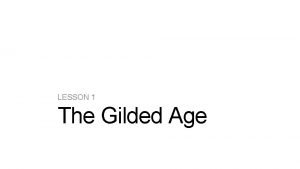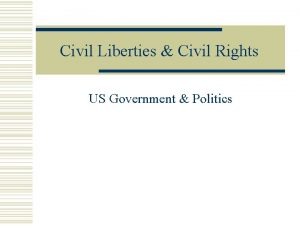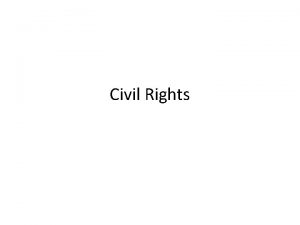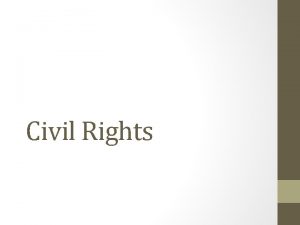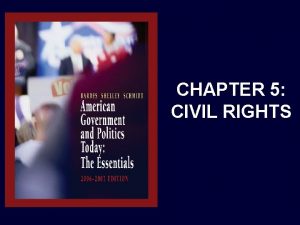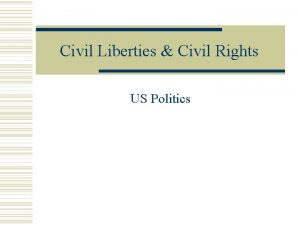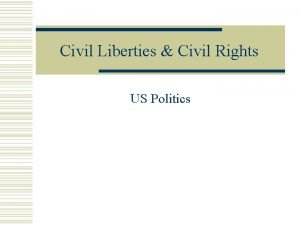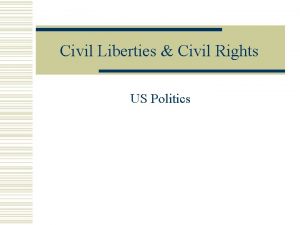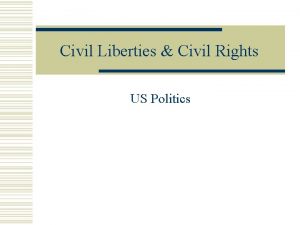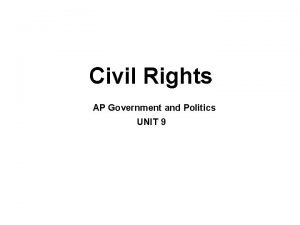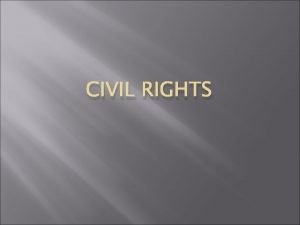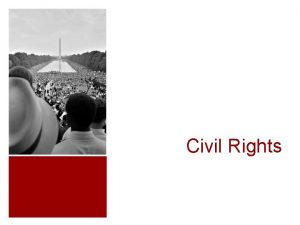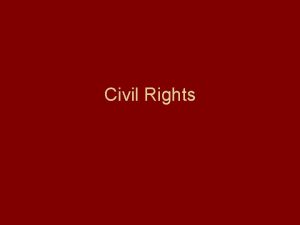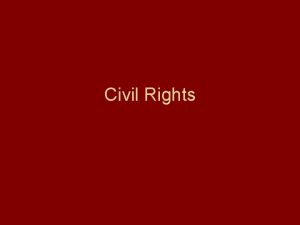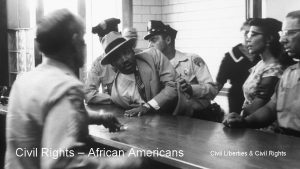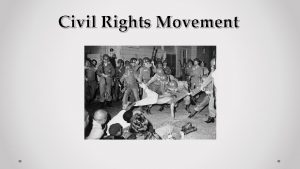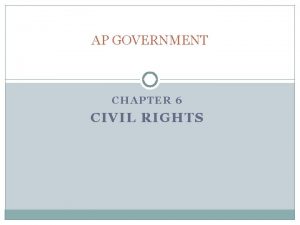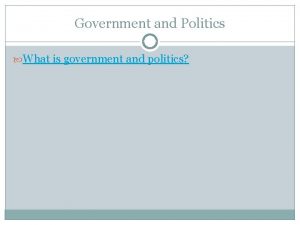Civil Rights AP Government and Politics UNIT 11



































































- Slides: 67

Civil Rights AP Government and Politics UNIT 11

Civil Liberties and Civil liberties. Rights. Civil Rights • The name given to • Provides freedom rights and freedoms from that protect the discriminatory individual from treatment by government and government or cannot be abridged. individuals, and protects to our • Civil liberties set rights, freedoms limits for and liberties which government so that no matter our race, it will not abuse its ethnicity, lifestyles, power and interfere or beliefs. with the lives of its

Civil Rights • The rights of personal liberty are guaranteed to U. S. citizens by the 5 th and 14 th Amendments to the Constitution and by acts of Congress. • The civil of citizens to vote, to receive equal treatment before the law, and to share equally with other citizens the benefits of public facilities.

Consider this quotation… “When a sixth of the population of a nation which has undertaken to be the refuge of liberty are slaves, and a whole country is unjustly overrun and conquered by a foreign army, and subjected to military law, I think that it is not too soon for honest men to rebel and revolutionize. What makes this duty the more urgent is the fact that the country so overrun is not our own, but ours is the invading army. ” -Henry David Thoreau Essay on Civil Disobedience

Consider this quotation… “Civil disobedience becomes a sacred duty when the state has become lawless or corrupt. And a citizen who barters with such a state shares in its corruption and lawlessness. ” -Mahatmas K. Gandhi An Autobiography of My Experiments with Truth

Consider this quotation… • “An individual who breaks a law that his conscience tells him is unjust, and who willingly accepts the penalty of imprisonment in order to arouse the conscience of the community over its injustice, is in reality expressing the highest respect for law. " -Dr. Martin Luther King, Jr. Letter from a Birmingham Jail

Consider these Questions… • Who is discriminated TODAY against in our society, and why? • What is the legacy of the Civil Rights Movement? • Is the battle for equal rights over? • Is it unfinished? • Was it largely successful? . . . unsuccessful?

The Government and Civil Rights • A powerful federal government was seen as the greatest threat to liberty in 1789. • Today, women and minorities look to the federal government for them equality. – This added role has increased the scope and power of the federal government.

Civil Rights Laws • Civil rights laws increased the power of government as it limits individual rights often the majority in order to protect the rights of the minority. • Liberals support the use of government powers to guarantee equality of opportunity for women and minorities • Conservatives support limited government powers and individualism, and do not always support governmental action

Important Amendments to Know for Test • 13 th Amendment • 14 th Amendment • 15 th Amendment • 19 th Amendment • 23 and 24 th Amendment • 26 th Amendment

Important Amendments to Know for Test • 13 th Amendment ended slavery • 14 th Amendment gave newly freed slaves citizenship rights – Also included the “Due Process Clause” and “Equal Protection Clause” which was expanded in 20 th century • 15 th Amendment gave African-American males the right to vote. – Because these three amendments were narrowly interpreted, Jim Crow laws continued to allow separate facilities and rules based on race. • 19 th Amendment- Gave women the right to vote • 24 th Amendment- Ended Poll Tax/ 23 -DC

Supreme Court Rulings on Discrimination • • • The U. S. Supreme Court has held that certain kinds of government discrimination are inherently suspect and must be subjected to strict judicial scrutiny. The suspect classification doctrine has its constitutional basis in the Fifth Amendment and the Equal Protection Clause of the Fourteenth Amendment, and it applies to actions taken by federal and state governments. FYI- The involvement of the state then makes these cases incorporation cases.

Supreme Court Rulings on Discrimination • When a suspect classification is at issue, the government has the burden of proving that the challenged policy is constitutional. • The Supreme Court has ruled that some particular groups or “Classifications” may not be discriminated against • Classifications that have been ruled on in the past include: – Age, religion, race, gender, national origin – And recently sexual orientation

Supreme Court Rulings on Classifications • Age – The Supreme Court has ruled that age classifications are “reasonable” AND constitutional • • (i. e…Age 18 for voting and 21 for drinking alcohol) Race – – It is illegal to discriminate because of race The Court has ruled that most classifications based on race or ethnicity are “inherently suspect. ” • Only exceptions are in the classification is designed to undo past discrimination (Affirmative Action).

Supreme Court Rulings on Classifications • Gender – The Court has ruled that classifications based on gender fit in-between being constitutional and unconstitutional • • (i. e…. The golf club at Augusta was for men only and this was ruled constitutional because it is a private institution but some public institutions and universities have been forced to accept women because they take public monies) Sexual orientation – • Homosexuals have not always been considered a suspect class. But the Court has ruled on several cases concerning gay rights since Bowers v Hardwick in 1986. The changing face of gay and lesbian rights has taken a “new road” in the United States since the controversial Stonewall riots in 1969. Current cases center around

The Constitutional Conception of Equality • Neither the Constitution nor the Bill of Rights mentions the word equality – The Declaration of Independence said, “all men are created equal. ” – This equality did not apply to women, slaves or Native Americans. • Race was first dealt with at the Constitutional Convention when the Framers established the 3/5 Compromise. – Was found in Article I, Section 2, Clause 3 but was superseded by the 14 th

Race and the Constitution • The Due Process Clause of the 5 th Amendment implies equal treatment under the law for all persons. – “No person (shall) be deprived of life, liberty, or property without due process of law; nor shall private property be taken for public use, without just compensation” • In Dred Scott v. Sanford (1857) the Supreme court ruled a black man, slave or free, was “chattel and had no rights” – Furthermore, Congress could not ban slavery in any territory of the United States. – Declared the Missouri Compromise unconstitutional

Important Civil Rights Cases & Acts • • *New Acts and Cases in Blue Equal Pay Act of 1963 Civil Rights Act of 1964 Voting Rights Act of 1965 E. R. A. (proposed amendment) Title IX Americans with Disabilities Act Lilly Ledbetter Law

The 14 th Amendment • Section 1. All persons born or naturalized in the United States, and subject to the jurisdiction thereof, are citizens of the United States and of the state wherein they reside. • No state shall make or enforce any law which shall abridge the privileges or immunities of citizens of the United States; nor shall any state deprive any person of life, liberty, or property, without due process of law; nor deny to any person within its jurisdiction the equal protection of the laws.

The Importance of the 14 th Amendment • The first and only mention of equality is in the 14 th Amendment, which prevents states from denying anyone “equal protection under the law. ” • The 14 th Amendment provided “equal protection of the laws” while establishing citizenship rights for newly freed slaves – Not until the 1950’s (Brown v. Board of Education) and 60’s (The Civil Rights Act 1964 and the Voting Rights Act) was the full force of the 14 th amendment felt and equal rights for women and minorities been protected.

The Birth of Jim Crow Laws • After the Civil War most states in the South passed anti-African American legislation. • These became known as Jim Crow laws. – This included laws that discriminated against African Americans with concern to attendance in public schools and the use of facilities such as restaurants, theaters, hotels, cinemas and public baths. – Trains and buses were also segregated and in many states marriage between whites and African American people.

Effects of Jim Crow • In Plessey, the Justices based their decision on the separatebut-equal doctrine, that separate facilities for blacks and whites satisfied the Fourteenth Amendment so long as they were equal. – In short, segregation does not in itself constitute unlawful discrimination • In the South especially, African Americans lived in fear of racially motivated violence. • “Jim Crow" laws barred African Americans from access to employment and to public places such as restaurants, hotels, and other facilities.

The 1964 Civil Rights Act • The 1964 Civil Rights Act made racial discrimination in public places, such as theaters, restaurants and hotels, illegal. – It also required employers to provide equal employment opportunities. – Projects involving federal funds could now be cut off if there was evidence of discriminated based on color, race or national origin. • The Civil Rights Act also attempted to deal with the problem of African Americans being denied the vote in the Deep South. – The legislation stated that uniform standards must prevail for establishing the right to vote. – Schooling to sixth grade constituted legal proof of literacy and the attorney general was given power to initiate legal action in any area where he found a pattern of resistance to the law.

Supporters of the Civil Rights bill in the Senate celebrate the cloture vote on June 10, 1964.

The 1965 Voting Rights Act • President Lyndon Baines Johnson attempted to persuade Congress to pass the Voting Rights Act in 1965. • This legislation removed the right of states to impose restrictions on who could vote in elections. – Johnson explained how, “Every American citizen must have an equal right to vote. Yet the harsh fact is that in many places in this country men and women are kept from voting simply because they are Negroes. " • Although opposed by politicians from the Deep South, the Voting Rights Act was passed by large majorities in the House of Representatives (333 to 48) and the Senate (77 to 19). – The legislation empowered the national government to register those whom the states refused to put on the voting list.


Voter Registration Rates (1965 vs. 1988) March 1965 November 1988 Black White Gap Alabama 19. 3 69. 2 49. 9 68. 4 75. 0 6. 6 Georgia 27. 4 62. 6 35. 2 56. 8 63. 9 7. 1 Louisiana 31. 6 80. 5 48. 9 77. 1 75. 1 -2. 0 Mississippi 6. 7 69. 9 63. 2 74. 2 80. 5 6. 3 North Carolina 46. 8 96. 8 50. 0 58. 2 65. 6 7. 4 South Carolina 37. 3 75. 7 38. 4 56. 7 61. 8 5. 1 Virginia 38. 3 61. 1 22. 8 63. 8 68. 5 4. 7

Number of Black Southern Legislators, 1868 -1900 and 19601992

Another Effect of the Voting Rights Act New African American Legislators • Blacks make up around 12. 1% of the population • But in 1965, only 70 African Americans held elected office in all 11 southern states. • That number rose to 2, 500 by the early 1980’s, after passage of the Voting Rights Act.

th 24 Amendment- 1964 • Section 1. The right of citizens of the United States to vote in any primary or other election for President or Vice President, for electors for President or Vice President, or for Senator or Representative in Congress, shall not be denied or abridged by the United States or any State by reason of failure to pay any poll tax or other tax. Section 2. The Congress shall have power to enforce this article by appropriate legislation.

Important Civil Rights Cases & Acts • • • *New Cases in Blue Brown v Board I and • Lemon vs. Kurtzman II • Plessey v. Ferguson CA Board of Regents • Reed v Bakke • Rostker v Goldberg Dred Scott v Sanford • Swann vs. Charlotte. Gratz v Bollinger Mecklenburg Grutter v Bollinger • Sweatt v Painter Hernandez v Texas • West Virginia BOE v H of Atlanta Motel v Barnette US • Wick Yo v Hopkins Korematsu v US Lawrence v Texas

Civil Rights Terms • De jure segregation – Separation by law (by law or “jury”) – Brown v Board 1954 • De facto segregation – Separation as a matter of fact (housing patterns, neighborhoods…) – Swann v Charlotte-Mecklenburg County Board of Education 1971

Swann v. Charlotte. Mecklenburg Board of Education (1971) Facts of the Case • • After the Supreme Court's decision in 1954 in Brown v. Board of Education, little progress had been made in desegregating public schools. • One example was the Charlotte. Mecklenburg, North Carolina, system in which approximately 14, 000 black students attended schools that were either totally black or more than 99 percent black. • Question • Were federal courts constitutionally authorized to oversee and produce remedies for state-imposed segregation?

Conclusion/Importance • In a unanimous decision, the Court said that the previous court decisions (such as Brown and Brown II) did not allow for such extreme de facto segregation. – The Charlotte-Mecklenburg Board of Education was forced to change the schools for many students and teachers. • Many school districts redrew district lines and in some cases bused students from their home schools

Other Minority Groups • Asian Americans are the fastest growing minority. – • • – Nearly 120, 000 Japanese-Americans and Japanese aliens were interned in concentration camps during WWII Korematsu v. US (1944) Hispanic Americans are the largest minority group in the US with increasing electoral influence Native-Americans were not made US citizens until 1924 – because of small size electorate, they benefit least from public policy and have the highest rate of poverty related problems

Korematsu v U. S. , 1944 • Facts of the Case • During World War II, Presidential Executive Order 9066 and congressional statutes gave the military authority to exclude citizens of Japanese ancestry from areas deemed critical to national defense and potentially vulnerable to espionage. Korematsu remained in San Leandro, California and violated Civilian Exclusion Order No. 34 of the U. S. Army. • Question • Did the President and Congress go beyond their war powers by implementing exclusion and restricting the rights of Americans of Japanese descent?

Korematsu v U. S. • Conclusion • The Court sided with the government and held that the need to protect against espionage outweighed Korematsu's rights and that Japanese internment was a “military necessity” during wartime. – Justice Black argued that compulsory exclusion, though constitutionally suspect, is justified during circumstances of "emergency and peril. “ • Congress authorized token compensation for loss of property and violation of rights years later.

Hernandez v Texas- 1953 • Facts of the Case • Pete Hernandez, an agricultural worker, was indicted for the murder an all white grand jury, and then convicted by an all -white jury. – A Mexican-American had not served on a jury in his county in over 25 years • Hernandez claimed that Mexican. American were discriminated against as a special class since they were not allowed to serve on his jury.

Hernandez v Texas • Question of Law • Does the 14 th Amendment provide equal protection for defendants of a particular race or ethnicity before a jury where all persons of his race or ancestry have, because of that race or ethnicity, been excluded by the state?

Hernandez v Texas • Question of Law • Does the 14 th Amendment provide equal protection for defendants of a particular race or ethnicity before a jury where all persons of his race or ancestry have, because of that race or ethnicity, been excluded by the state?

Hernandez v Texas • Importance • The Court ruled for Hernandez, and said that the 14 th Amendment extends to other racial groups in communities if it can be established that such a group exists within a community. • Thus, Mexican Americans were a "special class" entitled to equal protection under the 14 th

Women’s Rights • “Coverture” made married women subject to their husbands – Could not sign contracts or dispose of property. Divorce laws and child custody favored the husband. – Legal concept prevailed during the 19 th century.

Women’s Rights • 19 th Amendment – women’s right to vote • The Equal Pay Act of 1963 – businesses can not discriminate salaries because of gender • Civil Rights Act of 1964 (has a gender clause) • Reed v Reed 1971 • Lily Ledbetter law- 2009

Reed v Reed 1971 • Facts of the Case – After the death of their adopted son, both Sally and Cecil Reed sought to be named the administrator of their son's estate (the Reeds were separated). – The Idaho Probate Code specified that "males must be preferred to females" in appointing administrators of estates. – According to the Probate Code, Cecil was appointed administrator and Sally challenged the law in court. – Question – Did the Idaho Probate Code violate the Equal Protection Clause of the Fourteenth

Conclusion – In a unanimous decision, the Court held that the law's dissimilar treatment of men and women was unconstitutional. – The Court argued that "[t]o give a mandatory preference to members of either sex over members of the other, merely to accomplish the elimination of hearings on the merits, is…forbidden by the Equal Protection Clause of the Fourteenth Amendment. . . – The choice in this context may not lawfully be mandated solely on the basis of sex. "

The ERA and Title IX • The Equal Rights Amendment (ERA)Proposed! – Proposal by Congress in 1972 (both houses!) • Section 1. Equality of Rights under the law shall not be denied or abridged by the United States or any state on account of sex. • Section 2. The Congress shall have the power to enforce, by appropriate legislation, the provisions of this article. • Section 3. This amendment shall take effect two years after the date of ratification. – Never ratified • Only 35 states and 38 needed • The Education Amendment Act of 1972 – AKA… “Title IX” – Equity in sports at high school and college

Lily Ledbetter Fair Pay Act 2009 • Ms. Ledbetter discovered when she was nearing retirement that her male colleagues were earning much more than she was. • But in a 5 -4 decision, the Supreme Court threw out her case, ruling that she should have filed her suit within 180 days of the date that Goodyear first paid her less than her peers. • However, Congress changed the rules in 2009 and now the law covers wage discrimination regardless of when the discrimination began.

Women in the Military • Women are admitted to all military academies and make up 11% of the armed forces. – Only men must register for the draft • Rostker v Goldberg 1980 – However, women are allowed to serve in ground combat units (2013).

Rostker v Goldberg, 1980 • Facts of the Case • After the Soviet Union invaded Afghanistan in early 1980, President Jimmy Carter reactivated the draft registration process but wanted to include the registration of women in the Military Selective Service Act (MSSA), but Congress disagreed. • A number of men challenged the constitutionality of the MSSA, and the challenge was sustained by a district court. • Question • Did the MSSA's gender distinctions violate the Due Process Clause of the Fifth Amendment?

Conclusion • In a 6 -to-3 decision, the Court held that Congress's decision to exempt women from registration "was not the 'accidental by-product of a traditional way of thinking about females'" and did not violate the Due Process Clause. • The Court found that men and women, because of combat restrictions on women, were not "similarly situated" for the purposes of draft registration. • The Court also upheld Congress's judgment that the administrative and military problems that would be created by drafting women for noncombat roles were sufficient to justify the Military Selective Service Act.

Civil Rights for Seniors • 1975 Civil Rights law denied federal funds to any institution discrimination against people over 40 years of age. • 1978 law raised compulsory retirement age to 70 years. – AARP has significant political power as representative of senior citizens, a growing segment of the electorate.

Gay Rights • Gays in military – The “Don’t ask, don’t tell” policy was created during the Clinton administration • When recently polled voted all 4 branches of armed forces most said sexual orientation not important to them – The Obama administration pushed for the end of the policy which ended on Sept. 20, 2011 • Marine Gen. James F. Amos, called the repeal in September "a non-event. "

Important Court Cases • Bowers v Hardvick 1985 • The divided Court found that there was no constitutional protection for gays to engage in certain sexual acts, and that states could outlaw. • Lawrence v Texas 2002 • The Supreme Court ruled that a Texas statute had no legitimate state interest to justify its intrusion into the personal and private life of the gay individual.

Gay Rights- DOMA • The Defense of Marriage Act was a federal law passed in 1996 – Defined marriage as a legal union between one man and one woman for purposes of all federal laws, and provided that states need not recognize a marriage from another state if it is between persons of the same sex. – Obama administration has decided NOT to defend DOMA in court claiming that states have the right to decide on their own marriage laws – The Supreme Court ruled that DOMA was


Affirmative Action • Designed to overcome the effects of past discrimination, and bring about the increased employment, promotion or admission for women and minorities. – The goal is to “move beyond equal opportunity towards equal results”. • The federal government mandated affirmative action programs for state and local governments during the Nixon administration • Important cases dealing with Affirmative Action – Bakke case – University of Michigan cases, • Gratz and Grutter

Regents of the University of CA v Bakke, 1978 • Facts of Case – Allan Bakke, a thirty-five-year-old white man, had twice applied for admission to the University of CA Medical School. He was rejected both times. • Bakke's qualifications (college GPA and test scores) exceeded those of any of the minority students admitted in the two years his applications were rejected. – The school reserved 16 places in each entering class of 100 for "qualified" minorities, as part of the university's affirmative action program, in an effort to redress longstanding, unfair minority exclusions from the medical profession. – Bakke contended, first in the California courts, then in the Supreme Court, that he was excluded from admission solely on the basis of race.

Regents of the University of CA v Bakke, 1978 • Conclusion • The decision was 5 -4 and Bakke won his case but affirmative action was NOT found to be unconstitutional • However, the rigid use of racial quotas were found to violate the equal protection clause of the Fourteenth Amendment • Thus strict racial quotas were then generally found to be unconstitutional • Reverse discrimination case

Gratz v Bollinger, 2003 • Facts of the Case – The University of Michigan used race as a factor in making admissions decisions because it served a "compelling interest in achieving diversity among its student body. " – In addition, the University admitted virtually all qualified applicants who are members of one of three select racial minority groups - African Americans, Hispanics, and Native Americans - that are considered to be "underrepresented" on the campus. • Question of Law – Does the University of Michigan's use of racial preferences in undergraduate admissions violate the Equal Protection Clause of the Fourteenth Amendment or Title VI of the Civil Rights Act of 1964?

Importance • In a 6 -3 opinion delivered by Chief Justice William H. Rehnquist, the Court held that the University of Michigan's use of racial preferences in undergraduate admissions violates both the Equal Protection Clause and Title VI. – The automatic distribution of 20 points, or onefifth of the points needed to guarantee admission, to every single "underrepresented minority" applicant because of race was not narrowly tailored and did not provide the individualized consideration. • Chief Justice Rehnquist wrote, the University's use of race in its current freshman admissions policy, the policy violates the Equal Protection Clause. "

Grutter v Bollinger, 2003 • Facts of the Case • The University of Michigan Law School admitted that it used race as a factor in making admissions decisions because it serves a "compelling interest in achieving diversity among its student body. ". • Question • Does the University of Michigan Law School's use of racial preferences in student admissions violate the Equal Protection Clause of the Fourteenth Amendment or Title VI of the Civil

Importance • In a 5 -4 opinion delivered by Justice Sandra Day O'Connor, the Court held that the Equal Protection Clause does not prohibit the Law School's narrowly tailored use of race in admissions decisions to further a compelling interest in obtaining the educational benefits that flow from a diverse student body. – A highly individualized review of each applicant – No acceptance or rejection is based automatically on a variable such as race – This process ensures that all factors that may contribute to diversity are meaningfully considered alongside race. • Justice O'Connor wrote, "in the context of its individualized inquiry into the possible diversity contributions of all applicants, the Law School's race -conscious admissions program does not unduly harm non-minority applicants. "

The Americans with Disabilities Act • Americans with Disabilities Act was signed by President GHW Bush in 1990 • Required “reasonable accommodations” be made and prohibits discrimination in employment • The ADA prohibits private employers, or the government from discriminating against qualified individuals with disabilities in – – job application procedures hiring, firing, advancement compensation, job training and other terms, conditions and privileges of employment.


According to the ADA an individual with a disability is a person who: – Has a physical or mental impairment that substantially limits one or more major life activities; – Has a record of such an impairment; or is regarded as having such an impairment. – A qualified employee or applicant with a disability is an individual who, with or without reasonable accommodation, can perform the essential functions of the job in question.

• Reasonable accommodation may include, but is not limited to: – Making existing facilities used by employees readily accessible to and usable by persons with disabilities. – Job restructuring, modifying work schedules, reassignment to a vacant position; – Acquiring or modifying equipment or devices, adjusting modifying examinations, training materials, or policies, and providing qualified readers or interpreters.

Please read Chapter 5 and study your case file and notes!!!
 Civil rights webquest
Civil rights webquest Ap government unit 4 study guide
Ap government unit 4 study guide Unit 7 modern ga and civil rights
Unit 7 modern ga and civil rights Whose government politics populists and progressives
Whose government politics populists and progressives The nature of power politics and government
The nature of power politics and government La raza apush
La raza apush Chapter 14 postwar prosperity and civil rights
Chapter 14 postwar prosperity and civil rights Positive vs negative rights
Positive vs negative rights Characteristics of rights
Characteristics of rights Legal rights and moral rights
Legal rights and moral rights Negative right
Negative right Civil rights timeline of events
Civil rights timeline of events Civil rights sitins
Civil rights sitins Mother of the modern day civil rights movement
Mother of the modern day civil rights movement Define civil rights
Define civil rights Civil rights movement jeopardy
Civil rights movement jeopardy Usda civil rights training
Usda civil rights training Civil rights training certificate
Civil rights training certificate Goals of the civil rights movement
Goals of the civil rights movement Civil rights in child nutrition programs
Civil rights in child nutrition programs Civil rights graphic organizer
Civil rights graphic organizer Civil rights collage
Civil rights collage Civil rights choice board
Civil rights choice board Chapter 21 civil rights equal justice under law
Chapter 21 civil rights equal justice under law Chapter 20 civil liberties protecting individual rights
Chapter 20 civil liberties protecting individual rights Civil rights bell ringers
Civil rights bell ringers Truman supports civil rights
Truman supports civil rights Characteristics of civil rights
Characteristics of civil rights Civil rights cloze notes 1
Civil rights cloze notes 1 Lester maddox definition us history
Lester maddox definition us history Federally protected classes
Federally protected classes Title vi of the civil rights act of 1964
Title vi of the civil rights act of 1964 Civil rights in child nutrition programs
Civil rights in child nutrition programs Civil rights movement vocabulary
Civil rights movement vocabulary Unruh civil rights act real estate
Unruh civil rights act real estate Civil rights movement webquest
Civil rights movement webquest Civil rights movment
Civil rights movment Cacfp civil rights
Cacfp civil rights Title vii of the civil rights act
Title vii of the civil rights act Title vii of the civil rights act
Title vii of the civil rights act The civil rights movement
The civil rights movement Civil rights jeopardy
Civil rights jeopardy Civil rights movement essential questions
Civil rights movement essential questions What did sncc accomplish and how
What did sncc accomplish and how Chapter 20 civil liberties protecting individual rights
Chapter 20 civil liberties protecting individual rights Chapter 20 civil liberties protecting individual rights
Chapter 20 civil liberties protecting individual rights Littoral real estate
Littoral real estate What are negative rights
What are negative rights Negative rights vs positive rights
Negative rights vs positive rights Negative rights vs positive rights
Negative rights vs positive rights National government vs federal government
National government vs federal government Unit 4: civil war and reconstruction
Unit 4: civil war and reconstruction Unit 5 civil war and reconstruction
Unit 5 civil war and reconstruction Reconstruction vocabulary words
Reconstruction vocabulary words Health and social care values unit 2
Health and social care values unit 2 Unit 10, unit 10 review tests, unit 10 general test
Unit 10, unit 10 review tests, unit 10 general test Pearson applied law past papers
Pearson applied law past papers Unit 6 four market failures
Unit 6 four market failures Unit 6 market failures and the role of the government
Unit 6 market failures and the role of the government Power and politics in organizations
Power and politics in organizations What is the opportunities of informational
What is the opportunities of informational Lesson 5 african american culture and politics
Lesson 5 african american culture and politics Bureaucracy and politics in india
Bureaucracy and politics in india Power, politics and conflict in organizations
Power, politics and conflict in organizations Ethics and politics in social research bryman
Ethics and politics in social research bryman Conflict power and politics
Conflict power and politics Philosophy, politics and economics michael munger
Philosophy, politics and economics michael munger Lesson 1 - politics and the gilded age
Lesson 1 - politics and the gilded age


